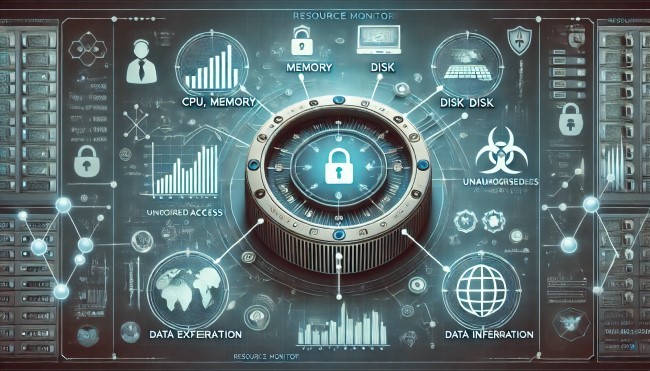Resource Monitors Used in Breaches: A Vital Tool for Cybersecurity
How Resource Monitors Are Leveraged in Detecting and Mitigating Data Breaches

Resource monitors are essential in cybersecurity, providing real-time system performance and activity insights. By tracking CPU, memory, disk, and network usage, these tools can identify abnormal behaviors indicative of breaches. Their ability to highlight unusual resource consumption makes them invaluable for early detection and mitigation of cyber threats.
Introduction
Cybersecurity is a critical concern for individuals and organizations in the digital age. Among the tools available to enhance security, resource monitors stand out for their ability to provide real-time insights into system performance and activity. This article explores the pivotal role of resource monitors in detecting and mitigating data breaches and details how these tools can be effectively used to enhance cybersecurity.
Understanding Resource Monitors
Resource monitors are software tools designed to track and display real-time data about the use of system resources, including CPU, memory, disk, and network activity. By providing a detailed view of how resources are used, these monitors help system administrators and users identify potential issues and optimize performance.
Key Features of Resource Monitors
- Real-Time Monitoring: Continuous tracking of system resource usage.
- Detailed Metrics: Information on CPU load, memory usage, disk I/O, and network activity.
- Anomaly Detection: Identification of unusual patterns that may indicate security breaches.
The Role of Resource Monitors in Breach Detection
Resource-monitors play a crucial role in cybersecurity by helping detect anomalies that could signify a data breach. By establishing a baseline of regular activity, these tools can identify deviations that warrant further investigation.
Identifying Unusual Activity
- CPU Spikes: Sudden increases in CPU usage can indicate the presence of malware or unauthorized processes.
- Memory Leaks: Excessive memory consumption might indicate a malicious application.
- Disk I/O Anomalies: Unusual disk activity could suggest data exfiltration.
- Network Traffic Surges: High network activity might indicate data being sent to unauthorized destinations.
Case Studies: Resource Monitors in Action
Several high-profile breaches have highlighted the importance of resource monitors in cybersecurity. In these cases, resource monitors were instrumental in identifying and mitigating threats before they could cause significant damage.
Case Study 1: Corporate Espionage
A multinational corporation discovered a significant data breach when their resource monitor detected unusual network activity. Upon investigation, it was revealed that sensitive data was being transferred to an external server. The timely detection allowed the company to halt the data transfer and secure its systems.
Case Study 2: Malware Infection
An organization experienced a sudden spike in CPU usage, flagged by their resource monitor. Further analysis revealed a malware infection designed to mine cryptocurrency. The resource monitor’s alert enabled the IT team to isolate the affected systems and remove the malware.
Implementing Resource Monitors for Enhanced Security
To maximize the effectiveness of resource monitors in preventing breaches, organizations should follow best practices for implementation and use.
Best Practices for Using Resource Monitors
- Regular Monitoring: Continuous monitoring to establish a baseline and detect anomalies promptly.
- Alert Configuration: Setting up alerts for specific thresholds to receive immediate notifications of suspicious activity.
- Integration with Other Tools: Combining resource-monitors with security tools like firewalls and intrusion detection systems for a comprehensive defense strategy.
- Routine Analysis: Regularly reviewing resource usage reports to understand normal behavior and spot deviations quickly.
Challenges and Limitations
While resource-monitors are powerful tools, they have limitations. Understanding these challenges is crucial for effective deployment and use.
Common Challenges
- False Positives: Resource monitors may flag legitimate activities as suspicious, leading to unnecessary investigations.
- Resource Consumption: Running resource monitors can consume system resources, potentially impacting performance.
- Complexity in Configuration: Properly configuring alerts and thresholds requires expertise and may be complex for some organizations.
Future Trends in Resource Monitoring
As cybersecurity threats evolve, so do the tools designed to combat them. The future of resource monitoring is likely to see advancements in several key areas.
Advancements in AI and Machine Learning
AI and machine learning algorithms can enhance resource monitors’ ability to detect anomalies by learning normal behavior patterns and more accurately identifying deviations.
Improved Integration with Security Systems
Future resource monitors will likely offer better integration with other cybersecurity tools, providing a more seamless and comprehensive approach to threat detection and mitigation.
Enhanced User Interfaces
Developments in user interface design will make resource monitors more accessible and easier to use, allowing even those without deep technical expertise to benefit from their capabilities.
Conclusion
Resource monitors are a vital component of modern cybersecurity strategies. By providing real-time insights into system performance and detecting unusual activity, they help organizations identify and respond to potential threats promptly. While they are not without challenges, the continued evolution of these tools promises to enhance their effectiveness and ease of use. Implementing resource monitors as part of a broader security strategy can significantly improve an organization’s ability to protect its data and systems from breaches.
This article has provided a comprehensive overview of the importance and application of resource-monitors in cybersecurity. Organizations can leverage these powerful tools to safeguard against data breaches and other cyber threats by following the best practices outlined and staying abreast of future trends.



